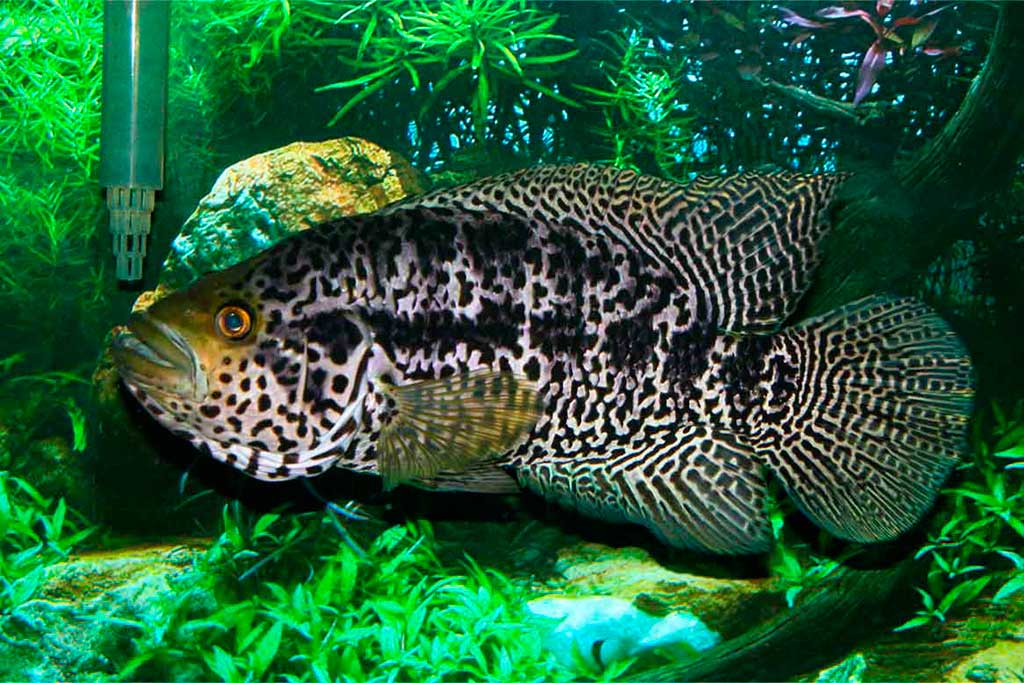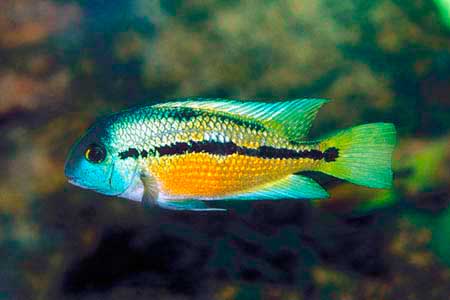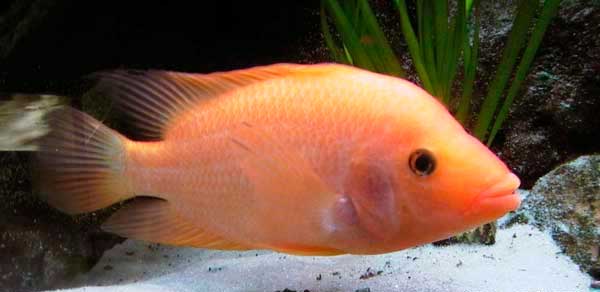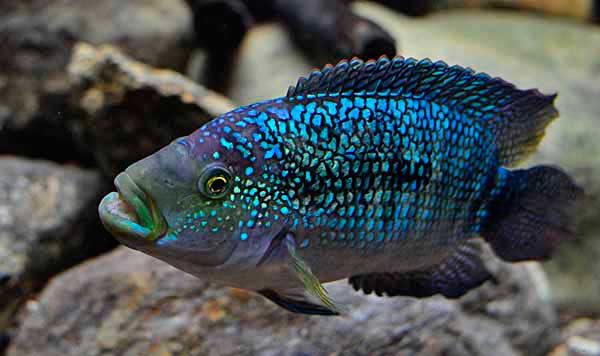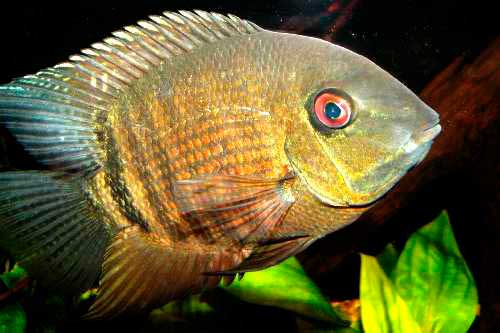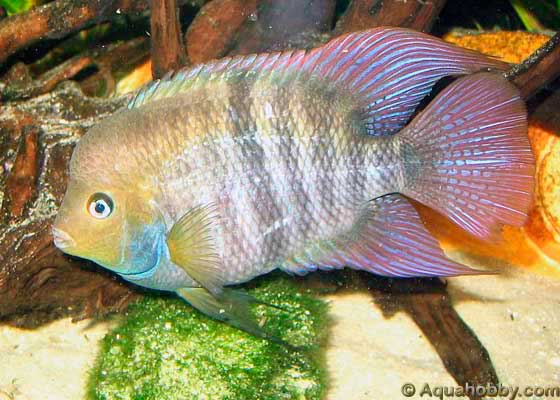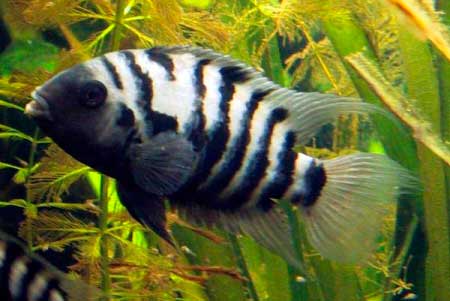The Managuan cichlazoma is a large member of the genus. It could hardly be recommended for a home artificial lake. But the office or the lobby of the enterprise, decorated with a large aquarium with these magnificent creatures, will look very spectacular.
| classification | |
|---|---|
| kingdom | Animals |
| Type | Chordates |
| Class | Radiant fish |
| Unit | Perch |
| Family | Cichlids |
| Genus | Cichlasoma |
| species | Parachromis managuensis |
Synonyms, names in other languages: Parachromis managuensis, Jaguar Cichlid, Jaguar guapote, Heros managuensis, Herichthys managuensis, Jaguar, Managa (slang).
Habitat – Central America. Water bodies of Nicaragua, namely Lake Managua. Inhabits water bodies of Costa Rica, Honduras. Artificially fishermen populated with it the water bodies of Mexico, Panama, Guatemala, Singapore, Florida (USA), El Salvador. That caused harm to the local flora and fauna because of the relatively inhospitable character and unrestrained gluttony of managas.
Managuan cichlazoma Description
The fish is large natural specimens reach half a meter in length. The largest caught specimen had a body sixty-three centimeters long. At the same time, it had a weight of 1580 grams.
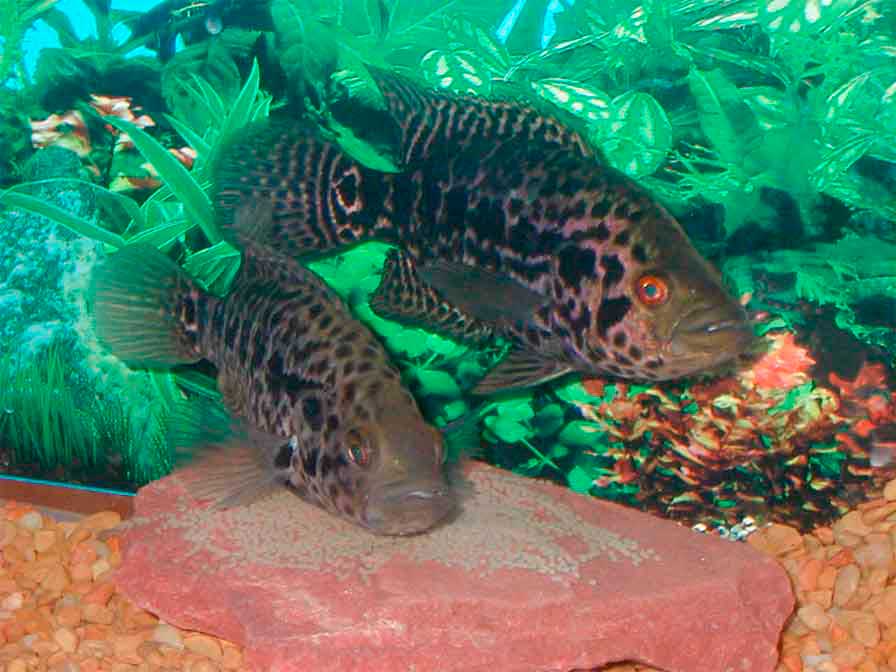
Specimens grown behind the glass of the aquarium, even under good conditions, reach, as a rule, a slightly smaller size, but thirty to forty centimeters for a room lake is also a giant. The body of the “jaguar” elongated, slightly flattened on the sides has a silvery background, on which scattered dark spots of black or dark brown shades. Thanks to these spots, the fish received another “folk” name, reminiscent of the beauty of the cat family. The pattern of spots on the body, as well as their outlines are very variable. To find two fish with the same pattern is very difficult. The head is large ending in a large mouth with thick lips. The iris of the eye is red. The dorsal fin extends to the base of the tail, ending in a pigtail. It is also decorated with spots of irregular outlines.
Does the golden Managuan cichlazoma exist?
Astorcui described a rare morphological form of this species around one thousand nine hundred and seventy-first year, which he called “Gold” (golden). This name was given because of the yellow coloration of the individuals. However, according to observations of the species behind the glass of a room water body, it is more logical to assume that this is not a morphological change, but an age-related one. This coloration is acquired by adult individuals, more precisely by elderly ones. This color can be compared with gray hair of an elderly person. And the rarity of such coloration in the bosom of nature is explained by the fact that in natural conditions it is more difficult for living organisms to live up to respectable gray hairs.
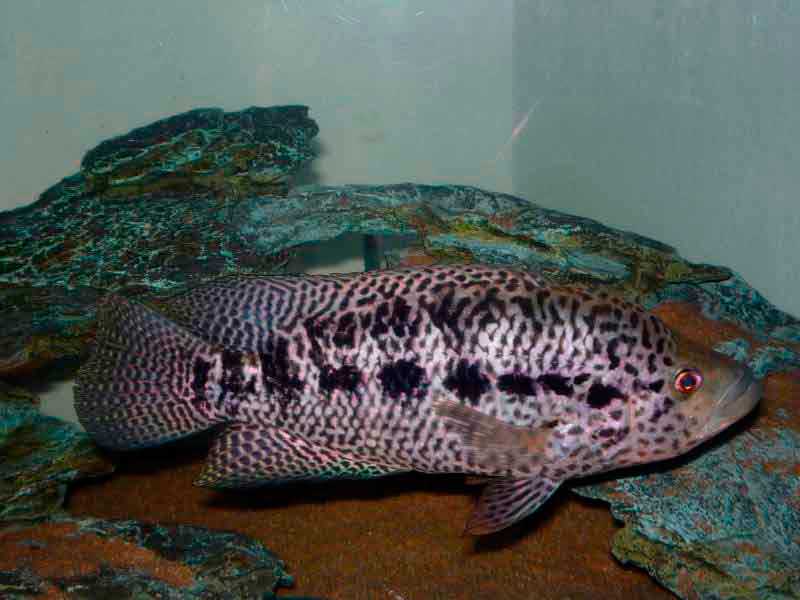
Managuan cichlazoma Sex Differences
These aquarium fish reach sexual maturity at about one year of age. The smallest female, caught from a natural reservoir (Little River Canal, Florida) ready to spawn had a body length of one hundred and sixteen millimeters. The smallest male suitable for reproduction had a body length of one hundred thirty-five millimeters. Aquariums of small volume contribute to the “tightening” of juvenile representatives of the species. Sometimes can breed individuals with a length of six to eight centimeters. Males, as in most other species of cichlids larger have a coarser outline.
A larger head and a more pronounced dorsal tubercle. Some authors mention the emerald shade of the dorsal fin in the male and its colorlessness in the female. Also females have a more silvery background of the body. In the male background coloration is dominated by golden shades. Due to the uneven growth of young animals on the size of different individuals in determining the sex should not be relied on. Therefore, it is only after the age of ten months that one can be at least somewhat sure of the sex characteristics.
Care and maintenance in the aquarium
Maintenance, except for the amount of habitat and selection of neighbors, is simple. The Managuan cichlazoma needs a large aquarium. One individual needs a volume of 60 – 80 liters. The displacement of the vessel for two adults should start from three hundred liters. If you plan to keep more fish or co-habitation with other species, you should count on a volume of at least 600 – 800 liters. For the content of fry can be used for some time containers from two hundred liters, but it should be taken into account that they can “linger” – stop growing and do not reach their majestic size even after the provision of more spacious housing. Therefore, about the growing tanks, as well as permanent reservoirs for these fish should be taken care of in advance, if you decide to engage them.
Soil
All cichlids are landscape transducers. The hero of our story also likes to drag pebbles on the bottom. And his enormous size makes him especially successful in this activity. In order to prevent constant modifications of the bottom surface and turbidity in the water column, the ground must be well washed. The best substrate for our case is probably coarse gravel, which is difficult to drag from place to place mixed with small and medium. You can not completely deprive them of pleasures. To decorate the bottom you can use large shells of mollusks, large snags.
It is believed that aquarium fish “jaguars” with plants are not compatible. This is due to the same habit of digging up the bottom. These giants are capable of digging up any plant.
Therefore, if you want greenery in your living underwater corner, I contrary to my beliefs, I have to recommend plastic fake. Although you can turn your eyes in the direction of fast-growing not rooting plants, such as Elodea canadensis, perhaps – cladophora spherical, you can also try to decorate the water column cattail.
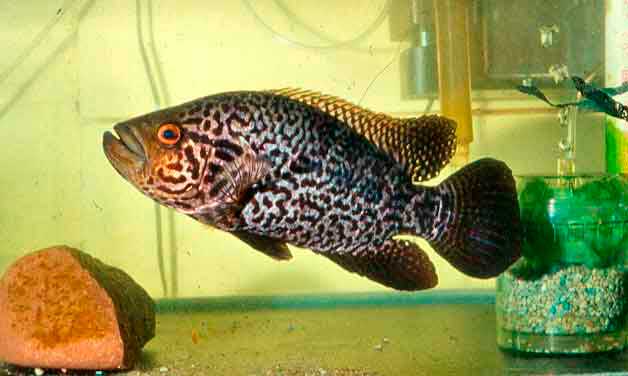
Recommended water parameters
In their natural habitat, liquid temperatures range from fifteen to thirty degrees Celsius. Some authors indicate that jaguars can withstand short-term temperature drops of up to twelve degrees Celsius. Nevertheless, it is not worth experimenting in this way. The optimum temperature for this species is 24-26°C. The pH should be maintained around 7, that is, the reaction of the medium should be neutral. The hardness is 15-25°dH.
The lighting should not be too bright. For its dimming, you can try to float on the surface of the water surface richchia or cassava.
Artificial aeration, filtration for the tank with this species is simply necessary. Since managi are very voracious, have large size and as a consequence solid metabolism, then even in the presence of moshnoy mechanical, biological filtration, aeration once a week is necessary substitution of 25-50% of fresh water. Otherwise, sooner or later will inevitably exceed the level of products of protein or salt metabolism. Which can end badly for your favorites. The first signs of a dangerous situation can be discerned by observing the fish. They become nervous, fearful, try to hide in a secluded place, their coloring becomes dark. If you notice something like this, immediately replace one-third of the water with fresh water.
Compatibility with other species can be discussed with a great deal of hesitation. Managuan cichlasoma can be kept with other species of the same size and with a similar temperament. Sami “jaguars” rarely attack their neighbors, but the aggressor, encroaching on the favorite cobblestone, will not let down. This applies to neighbors commensurate with them in size. As for the fish that can fit in the mouth of a managi, they are not neighbors – they are food.
What to feed it with?
The Managuan cichlasoma is an obligate predator. Eat anything that moves and fits in the mouth. You can feed small fish. For one meal an adult can swallow up to a dozen adult swordfish. But, I think it is better not to practice cannibalism, especially since the “jaguars” unpretentious in the choice of dishes. You can feed large moths, earthworms, shrimp, large insects, small reptiles, frog tadpoles, minced meat, large flakes of dry food.
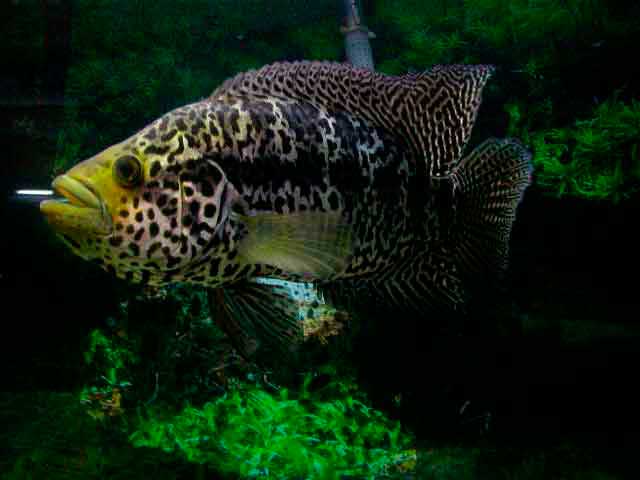
Managuan cichlazoma Reproduction
In the wild, Heros managuensis breed from November to October. The peak occurs in June.
Aquarium fish Managuan cichlasoma can breed in a common aquarium, but for general peace of mind it will be more useful to allocate them during spawning a separate living space of about three hundred liters. Water parameters are the same as in the decorative content. Except that the temperature is desirable to raise the temperature by two degrees, stabilizing it at 28 ° C. If spawning has not started in the expected time frame, it can be tried to stimulate it by replacing 25% of the water with fresh tempered water of the same temperature.
As stated earlier, managi reach sexual maturity by the tenth to twelfth month of life. Before spawning, the producers form a sweet pair.
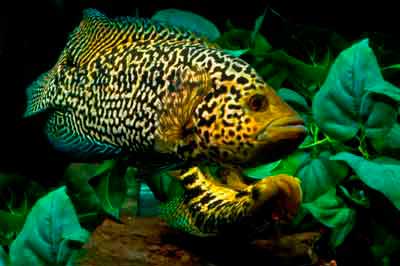
However, to the next spawning male will try to find another girlfriend, if there is such an opportunity. Having found a secluded place, spouses clean it and rebuild it to their liking. Eggs can be laid on a large flat stone, flower pot, large snags. The female can sweep out at one time from one to five thousand large yellowish shade of transparent eggs. Incubation lasts from two to three days. After the appearance of fry should be fed small crustaceans (daphnia, Artemia nauplii).
Caring for fry
As the fry grow, they should be fed larger feeds. The growth of fry is cyclical. They may reach 15 centimeters in length during the first four months of life. It may then take them another year to a year and a half to reach adult size. Fry do not grow evenly. Among the representatives from one spawning may meet individuals of very different weight categories. Therefore, to prevent cannibalism, they should be sorted from time to time, seeding on different breeding tanks. I dare to remind you that if in time the fry do not provide a tank of sufficient size, then it will stop its growth and will never reach its greatness, for which so valued this fish many aquarists, which of course have space to accommodate an aquarium of appropriate capacity.
These are such aquarium fish. It remains only to add that in its homeland, the Managuan cichlazoma is a commercial fish, representing a desirable dish for the dinner table. It is also an object of sport fishing.
